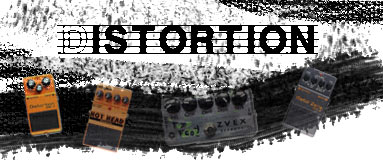Distortion is absolutely necessary if a guitar player is to play any type of rock or metal. Basic distortion seeks to “dirty up” a signal, and to make it sound more dynamic or “crunchy.” Out of the basic distortion family, there is overdriven, fuzz, crunch, high gain types of distortion.

Figure 1 – There are several basic types of distortion that guitar players should explore. Fuzz crunch, overdrive, and high-gain will be the most common.
Overdriven distortion is much like the name implies- the signal is cut off at a certain frequency to distort the signal. This is the most basic and common of the four main basic distortion types. These types of edals almost always use solid-state design, although some pedals can be found to incorporate tubes for and edgier sound. The most popular pedals in this class of distortion come from Digitech, Boss, Line 6, and Marshall.
 |
 |
 |
 |
Figure 2 – (From left to right) The Boss DS-1, the Digitech Hot Head, the Marshall Guv’Nor, and the Line 6 Dr. Distorto.
The Boss DS-1 offers a sturdy solution for around $40-listen to sample.
The Digitech Hot Head offers a competitive price at around $40- listen to sample.
The Marshall Guv’nor is a bit higher priced at around $70-listen to sample.
The Line 6 Dr. Distorto offers a more expensive price at $99-listen to sample.
Fuzz distortion pedals also sound like the name implies- a fuzzy type of raunchy distortion that became popular in the 1960s. Guaranteed to turn the weakest solo into a monster! As usual Boss and Electro-Harmonix make great fuzz pedals, but look out for the Keeley Fuzz head which has incredible versatility.
 |
 |
 |
Figure 3 – The Boss FZ-5 Fuzz, Electro-Harmonix Little Big Muff, and the Keeley Fuzz Head.
The Boss FZ-5 Fuzz pedal comes in at $120, but offers great tone control- listen to sample.
The Electro-Harmonix Big Muff is a more modest $70, which is considerably cheaper- listen to sample.
The Keeley Fuzz Head can easily cost a couple of hundred dollars, but is worth every cent! listen to samples.
Metal fans will undoubtedly flock to the high-gain distortions that offer high-crunch, grit, and head banging worthy tones that bring new life to a guitar. Digitech and Boss have almost a complete monopoly on this section of distortion, and choosingbetween the two can be somewhat difficult- both are competitively priced and of great quality.
 |
 |
Figure 4 – The Boss Metal Zone, and the Digitech MetalMaster.
The Boss Metal Zone will offer a great metal sound at around $90- listen to sample.
The Digitech MetalMaster even has an optional control for morphing, and costs just a bit cheaper than the Boss Metal Zone- listen to sample.
Last but not least, the crunch distortion that is popular among grunge and older rock bands is almost a guaranteed hit with guitar players. Boss, Digitech, and Ibanez dominate the market with their crunchy distortion pedals.
 |
 |
 |
Figure 5 – The Boss SD-1, Digitech Bad Monkey, and Ibanez Tube Screamer.
The Boss SD-1 is just $50, and is sure to please- listen to sample.
The Digitech Bad Monkey is a little cheaper at $40- listen to sample.
Lastly, the Ibanez Vintage Tube Screamer is a bit pricier at around $170, but it is considered to be the best in a few respects- there is no better sample of this distortion pedal than to listen to Metallica’s “Nothing Else Matters.” While the Ibanez Tube Screamer is actually best for Blues and older Rock, it is commonly used in grunge bands to get a very unique crunch sound in modern day society.
Deciding on which distortion pedal to go for can be hard, the best solution is to ask friends or local music stores if you can test a few out to see what is best for a particular playing style. Basic distortion such as fuzz, overdrive, crunch, and high-gain are just the start; more flashier effects achieved through delays and filters are available to guitar players too. If you are a rock guitarist, these distortion pedals are almost completely necessary. Try out a few istortion pedals, and have fun!.

Hey Zac,
Nice post. Thanks for breaking this down. With all the different types it can get confusing. Just one comment, though: I think the Ibanez TS( (and clones of it) are more of a classic overdrive that creates distorion by pushing the signal (or “overdriving” it). I wouldn’t really classyfy it as a “crunch” distortion. I actually think the Boss DS-1 is more of a crunch distortion than the tube screamers.
Tubescreamers are used a lot by blues and rock players (SRV, Trey Anastasio, Van Halen, just to name a few off the top of my head).
Just my $.02, but i could be mistaken.
You’re correct, actually. I put it in the crunch area of distortion because of what I see it used for, but you are completely correct.
Tube screamers are mostly for blues and old rock, but are also likewise good for putting out a unique crunch sound with the right settings- by no means is it a “heavy crunch”.
Thanks for the interest, I added a little more information in that paragraph about it.